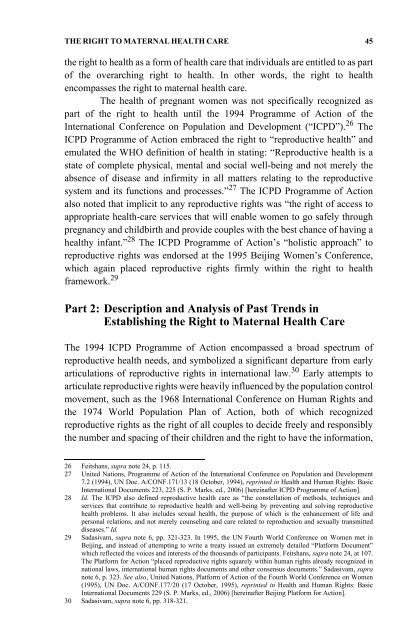University of Botswana Law Journal - PULP
University of Botswana Law Journal - PULP
University of Botswana Law Journal - PULP
You also want an ePaper? Increase the reach of your titles
YUMPU automatically turns print PDFs into web optimized ePapers that Google loves.
THE RIGHT TO MATERNAL HEALTH CARE 45<br />
the right to health as a form <strong>of</strong> health care that individuals are entitled to as part<br />
<strong>of</strong> the overarching right to health. In other words, the right to health<br />
encompasses the right to maternal health care.<br />
The health <strong>of</strong> pregnant women was not specifically recognized as<br />
part <strong>of</strong> the right to health until the 1994 Programme <strong>of</strong> Action <strong>of</strong> the<br />
International Conference on Population and Development (“ICPD”). 26 The<br />
ICPD Programme <strong>of</strong> Action embraced the right to “reproductive health” and<br />
emulated the WHO definition <strong>of</strong> health in stating: “Reproductive health is a<br />
state <strong>of</strong> complete physical, mental and social well-being and not merely the<br />
absence <strong>of</strong> disease and infirmity in all matters relating to the reproductive<br />
system and its functions and processes.” 27 The ICPD Programme <strong>of</strong> Action<br />
also noted that implicit to any reproductive rights was “the right <strong>of</strong> access to<br />
appropriate health-care services that will enable women to go safely through<br />
pregnancy and childbirth and provide couples with the best chance <strong>of</strong> having a<br />
healthy infant.” 28 The ICPD Programme <strong>of</strong> Action’s “holistic approach” to<br />
reproductive rights was endorsed at the 1995 Beijing Women’s Conference,<br />
which again placed reproductive rights firmly within the right to health<br />
framework. 29<br />
Part 2: Description and Analysis <strong>of</strong> Past Trends in<br />
Establishing the Right to Maternal Health Care<br />
The 1994 ICPD Programme <strong>of</strong> Action encompassed a broad spectrum <strong>of</strong><br />
reproductive health needs, and symbolized a significant departure from early<br />
articulations <strong>of</strong> reproductive rights in international law. 30 Early attempts to<br />
articulate reproductive rights were heavily influenced by the population control<br />
movement, such as the 1968 International Conference on Human Rights and<br />
the 1974 World Population Plan <strong>of</strong> Action, both <strong>of</strong> which recognized<br />
reproductive rights as the right <strong>of</strong> all couples to decide freely and responsibly<br />
the number and spacing <strong>of</strong> their children and the right to have the information,<br />
26 Feitshans, supra note 24, p. 115.<br />
27 United Nations, Programme <strong>of</strong> Action <strong>of</strong> the International Conference on Population and Development<br />
7.2 (1994), UN Doc. A/CONF.171/13 (18 October, 1994), reprinted in Health and Human Rights: Basic<br />
International Documents 223, 225 (S. P. Marks, ed., 2006) [hereinafter ICPD Programme <strong>of</strong> Action].<br />
28 Id. The ICPD also defined reproductive health care as “the constellation <strong>of</strong> methods, techniques and<br />
services that contribute to reproductive health and well-being by preventing and solving reproductive<br />
health problems. It also includes sexual health, the purpose <strong>of</strong> which is the enhancement <strong>of</strong> life and<br />
personal relations, and not merely counseling and care related to reproduction and sexually transmitted<br />
diseases.” Id.<br />
29 Sadasivam, supra note 6, pp. 321-323. In 1995, the UN Fourth World Conference on Women met in<br />
Beijing, and instead <strong>of</strong> attempting to write a treaty issued an extremely detailed “Platform Document”<br />
which reflected the voices and interests <strong>of</strong> the thousands <strong>of</strong> participants. Feitshans, supra note 24, at 107.<br />
The Platform for Action “placed reproductive rights squarely within human rights already recognized in<br />
national laws, international human rights documents and other consensus documents.” Sadasivam, supra<br />
note 6, p. 323. See also, United Nations, Platform <strong>of</strong> Action <strong>of</strong> the Fourth World Conference on Women<br />
(1995), UN Doc. A/CONF.177/20 (17 October, 1995), reprinted in Health and Human Rights: Basic<br />
International Documents 229 (S. P. Marks, ed., 2006) [hereinafter Beijing Platform for Action].<br />
30 Sadasivam, supra note 6, pp. 318-321.
















